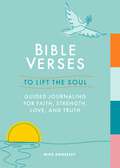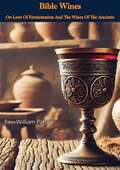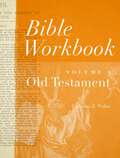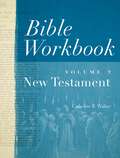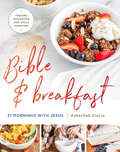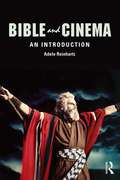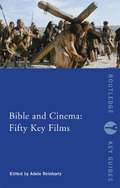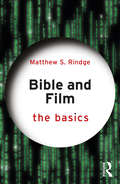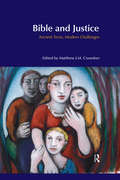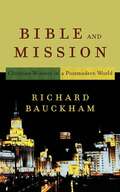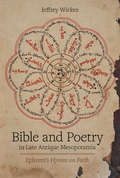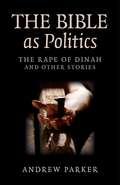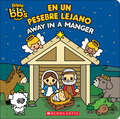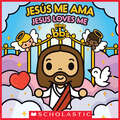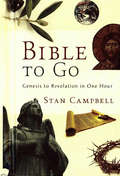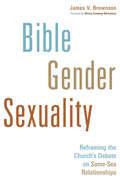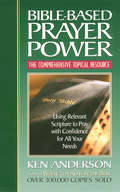- Table View
- List View
Bible Truths: Learning from the Life of Christ, Level A (4th edition)
by Stephen J. Hankins Mark L. Ward Jr.This book is based on the life of Christ and inspires students to live like him.
Bible Truths: The Story of the Old Testament, Level B (4th Edition)
by Bju PressThe all new student text for Bible Truths B: The Story of the Old Testament takes an exciting and different approach to Bible study. Instead of presenting the Old Testament as a series of unconnected stories, it teaches the student the Bible's one story. God is at work redeeming His fallen creation-climactically through Jesus-and every small story in the Bible makes sense only in light of that big story. The Old Testament still teaches moral lessons, but Gideon and Noah and Moses are not the big heroes; God is. Bible Truths B: The Story of the Old Testament covers the historical books as well as "The Writings"-Job, Psalms, Proverbs, Ecclesiastes, and Song of Solomon are covered in extensive feature boxes. Critical thinking questions follow every section of the student text, helping students to remember, understand, and apply Scripture.
Bible Verses to Lift the Soul: Guided Journaling for Faith, Strength, Love and Truth
by Mike AnnesleyPacked with resonant and thoughtful reflections, chosen as indispensable signposts for all who wish to make the best possible progress on life's journey.Offering inspiration for any situation you might face, Bible Verses to Lift the Soul is the perfect easy-to-use life companion, full of invaluable insights to steer you through your days and weeks.Reflection helps us to become more self-aware, and guided journaling is a great tool to enhance our everyday self-reflective practice. The Bible offers timeless wisdom - the 52 verses with accompanying prompts in this journal have been carefully selected to help you navigate life's challenges.Let faith, strength, love and truth guide you to greater peace.
Bible Verses to Lift the Soul: Guided Journaling for Faith, Strength, Love and Truth
by Mike AnnesleyPacked with resonant and thoughtful reflections, chosen as indispensable signposts for all who wish to make the best possible progress on life's journey.Offering inspiration for any situation you might face, Bible Verses to Lift the Soul is the perfect easy-to-use life companion, full of invaluable insights to steer you through your days and weeks.Reflection helps us to become more self-aware, and guided journaling is a great tool to enhance our everyday self-reflective practice. The Bible offers timeless wisdom - the 52 verses with accompanying prompts in this journal have been carefully selected to help you navigate life's challenges.Let faith, strength, love and truth guide you to greater peace.
Bible Wines: On Laws Of Fermentation And The Wines Of The Ancients
by Rev William Patton"Bible Wines: On Laws of Fermentation and the Wines of the Ancients" by Rev. William Patton is a meticulously researched exploration of the nature and significance of wines mentioned in the Bible. Patton, a respected scholar and clergyman, delves into the historical, cultural, and scientific aspects of fermentation and wine production in ancient times, providing a comprehensive understanding of this important biblical subject.In this illuminating work, Patton investigates the various types of wines referenced in the Scriptures, distinguishing between fermented and unfermented beverages. He offers a detailed analysis of the ancient processes of fermentation, explaining the natural laws that govern it and the methods employed by ancient civilizations to produce different kinds of wine. Patton's scholarly approach is grounded in a deep respect for the biblical text, aiming to reconcile historical practices with scriptural teachings."Bible Wines" addresses common misconceptions and debates surrounding the use of wine in biblical times, particularly concerning the consumption of alcohol. Patton provides context to the temperance movement of his era, advocating for a clearer understanding of what the Bible truly says about wine. His thorough research includes references to ancient texts, archaeological findings, and historical accounts, making a compelling case for his interpretations.The book is not only a study of biblical wines but also a broader reflection on the role of alcohol in society, offering insights into the moral and ethical considerations surrounding its use. Patton's thoughtful and balanced perspective encourages readers to think critically about the implications of wine consumption in their own lives, guided by the wisdom of ancient practices and biblical principles."Bible Wines: On Laws of Fermentation and the Wines of the Ancients" is an essential read for theologians, historians, and anyone interested in the intersection of faith, history, and science. Rev. William Patton's work stands as a valuable resource for understanding the complex and nuanced role of wine in the biblical world and its relevance to contemporary discussions on temperance and morality.
Bible Workbook Vol. 1 Old Testament: Volume 1 Old Testament
by Catherine B. WalkerNOW WITH UPDATED, FULL-COLOR MAPSThe Bible Workbooks are a systematic, individual study of the Bible, providing a thorough biblical understanding. The student learns by doing; information is given and questions are asked to test their understanding. Bible Workbook Volume 1 gives an overview and a book-by-book study of the Old Testament. Interesting, stimulating, and informative, Bible Workbooks provide an understandable and enjoyable means of personal Bible study.
Bible Workbook Vol. 1 Old Testament: Volume 1 Old Testament
by Catherine B. WalkerNOW WITH UPDATED, FULL-COLOR MAPSThe Bible Workbooks are a systematic, individual study of the Bible, providing a thorough biblical understanding. The student learns by doing; information is given and questions are asked to test their understanding. Bible Workbook Volume 1 gives an overview and a book-by-book study of the Old Testament. Interesting, stimulating, and informative, Bible Workbooks provide an understandable and enjoyable means of personal Bible study.
Bible Workbook Vol. 2 New Testament
by Catherine B. WalkerNOW WITH UPDATED, FULL-COLOR MAPSThe Bible Workbooks are a systematic, individual study of the Bible. The student learns by doing; information is given and questions are asked to test their understanding. Bible Workbook Volume 2 gives an overview and a book-by-book study of the New Testament. Interesting, stimulating, informative- Bible Workbooks provide an understandable and enjoyable means of personal Bible study.
Bible Workbook Vol. 2 New Testament
by Catherine B. WalkerNOW WITH UPDATED, FULL-COLOR MAPSThe Bible Workbooks are a systematic, individual study of the Bible. The student learns by doing; information is given and questions are asked to test their understanding. Bible Workbook Volume 2 gives an overview and a book-by-book study of the New Testament. Interesting, stimulating, informative- Bible Workbooks provide an understandable and enjoyable means of personal Bible study.
Bible and Breakfast: 31 Mornings with Jesus--Feeding Our Bodies and Souls Together
by Asheritah CiuciuAre you starting your day on empty?Before your feet hit the ground, chaos drowns out any hope of quiet time with Jesus, as the alarm blares, kids run around the house, and your to-do list reminds you that you&’re already behind. Bible and Breakfast is for you. In just a month, you&’ll kickstart a morning habit of meeting with Jesus and eating a healthy breakfast every day. Join Bible teacher and author Asheritah Ciuciu for 31 devotions for busy women and 31 tasty breakfast recipes.EACH DEVOTION INCLUDES: FEAST Bible Study prompts for days you want to dig deepSnack on-the-go devotionals for busy daysPlenty of space for journaling and respondingRECIPES FEATURE: Family favorites that are healthy enough to feel good about and tasty enough that your kids will eat them A full color photo for every recipeLots of gluten-free, kid-friendly, and freezer-friendly optionsNo more waiting for the perfect time and place. Experience the joy of starting your mornings with Jesus today.
Bible and Breakfast: 31 Mornings with Jesus--Feeding Our Bodies and Souls Together
by Asheritah CiuciuAre you starting your day on empty?Before your feet hit the ground, chaos drowns out any hope of quiet time with Jesus, as the alarm blares, kids run around the house, and your to-do list reminds you that you&’re already behind. Bible and Breakfast is for you. In just a month, you&’ll kickstart a morning habit of meeting with Jesus and eating a healthy breakfast every day. Join Bible teacher and author Asheritah Ciuciu for 31 devotions for busy women and 31 tasty breakfast recipes.EACH DEVOTION INCLUDES: FEAST Bible Study prompts for days you want to dig deepSnack on-the-go devotionals for busy daysPlenty of space for journaling and respondingRECIPES FEATURE: Family favorites that are healthy enough to feel good about and tasty enough that your kids will eat them A full color photo for every recipeLots of gluten-free, kid-friendly, and freezer-friendly optionsNo more waiting for the perfect time and place. Experience the joy of starting your mornings with Jesus today.
Bible and Cinema: An Introduction
by Adele ReinhartzThis is a comprehensive introduction to the ways in which the Bible has been used and represented in mainstream cinema. Adele Reinhartz considers the pervasive use of the Bible in feature films, and the medium of film as part of the Bible's reception history. The book examines how films draw on the Old and New Testament and the figure of Jesus Christ in various direct and indirect ways to develop their plots, characters, and themes. As well as movies that set out explicitly to retell biblical stories in their ancient context, it explores the ways in which contemporary, fictional feature films make use of biblical narrative. Topics covered include: how filmmakers make use of scripture to address and reflect their own time and place. the Bible as a vehicle through which films can address social and political issues, reflect human experiences and emotions, explore existential issues such as evil and death, and express themes such as destruction and redemption. the role of the Bible as a source of ethics and morality, and how this connection is both perpetuated and undermined in a range of contemporary Hollywood films. films that create an experience of transcendence, and the ways in which the Bible figures in that experience. Reinhartz offers insightful analysis of numerous films including The Ten Commandments and The Shawshank Redemption, paying attention to visual and aural elements as well as plot, character, and dialogue. Students will find this an invaluable guide to a growing field.
Bible and Cinema: An Introduction
by Adele ReinhartzBible and Cinema: An Introduction is a comprehensive examination of how the Bible has been used and represented in mainstream cinema to develop its plots, characters, and themes. The book considers two general types of films: Bible movies that retell biblical stories, such as the Exodus and the life of Jesus, and Bible-related movies that make use of biblical books, stories, verses, and figures, and Bibles themselves to tell non-biblical, often fictional, narratives. Topics covered include: the contribution of Bible and Bible-related movies to the history of the Bible’s reception; the ways in which filmmakers make use of scripture to address and reflect their own time and place; the Bible as a vehicle through which films can address social and political issues, reflect human experiences and emotions, explore existential issues such as evil and death, and express themes such as destruction and redemption; the role of the Bible as a source of ethics and morality, and how this role is both perpetuated and undermined in a range of contemporary Hollywood films; and film as a medium for experiences of transcendence, and the role of the Bible in creating such experiences. This thoroughly updated second edition includes insightful analysis of films such as Noah, Gods and Men, Mary Magdalene, and The Shawshank Redemption, paying attention to visual and aural elements as well as plot, character, and dialogue. The book also includes pedagogical resources including discussions of film theory, as well as key words and discussion questions. Teachers, students, and anyone interested in the intersection of Bible and cinema will find this an invaluable guide to a growing field.
Bible and Cinema: Fifty Key Films (Routledge Key Guides)
by Adele ReinhartzMovies which have drawn inspiration from the Bible, either directly or indirectly, have been extremely popular since the earliest days of cinema. Bible and Cinema: Fifty Key Films introduces a wide range of those movies, which are among the most important, critically-acclaimed and highest-grossing films of all time, including: The King of Kings Ben-Hur The Passion of the Christ Frankenstein Close Encounters of the Third Kind 2001: A Space Odyssey Apocalypse Now Monty Python’s Life of Brian. Written by a team of international scholars, the fifty entries discuss the Biblical stories, characters or motifs depicted in each film making this book the ideal guide for anyone interested in the long-standing relationship between the Bible and film.
Bible and Film: The Basics (The Basics)
by Matthew S. RindgeBible and Film: The Basics is a concise, accessible, and illuminating introduction to the study of Bible and Film. The book introduces non-specialists to the essential content in Bible and Film, and to some of the most common and important methods Bible and Film scholars use. Questions asked throughout the book include: How do films (re)interpret and illuminate biblical texts? How do films appropriate, reconfigure, and transform biblical texts? How does a film's treatment of biblical texts help interpret and illuminate the film? This book examines various types of interplay between film and the Bible. The theme of ‘Bible on film’ is explored through Hebrew Bible epics including The Prince of Egypt and Noah, and Jesus films such as The Last Temptation of Christ and Son of Man. The theme ‘Bible in film’ is analyzed through films including Mary Magdalene, Magnolia, Pulp Fiction, and The Book of Eli. Films that ‘reimagine the Bible’ include Ex Machina, mother!, and The Tree of Life; unusual Jesus figures in Pan’s Labyrinth, Dogville, and Donnie Darko are also explored. ‘Film as Bible’ considers films such as To the Wonder, Silence, and Parasite. A conclusion examines television shows such as Dekalog, The West Wing, The Handmaid’s Tale, and God on Trial. With a glossary of key terms and suggestions for further reading throughout, this book is an ideal starting point for anyone seeking a full introduction to religion and film, bible and film, bible and popular culture, and theology and film.
Bible and Justice: Ancient Texts, Modern Challenges (BibleWorld)
by Matthew J. CoomberThe Bible contains a variety of passages that defend the poor and champion the cause of the oppressed, but are these ancient texts able to find a voice in confronting injustice in the modern world? 'Bible and Justice' examines the ways in which the Bible can speak to contemporary poverty, environmental issues, and state-sponsored violence, whilst exploring the difficulties that arise when ancient concepts of justice are applied to modern ideals. The book covers a range of topics from human rights to deaf biblical interpretation and from hospitality to corporate globalization. Broad and accessible, 'Bible and Justice' will be an invaluable resource for students of religious and biblical studies.
Bible and Mission: Christian Witness in a Postmodern World
by Richard BauckhamThis engaging study provides a new way of looking at Scripture--one that takes seriously the biblical idea of mission. Richard Bauckham shows how God identifies himself with particular individuals or people in human history in order to be known by all. He is the God of Abraham, Israel, and David and, finally, the one who acts through Jesus Christ. Bauckham applies these insights to the contemporary scene, encouraging those involved in mission to be sensitive to postmodern concerns about globalization while at the same time emphasizing the uniqueness of Christian faith. In doing so, he demonstrates the diversity of Christian faith around the world. This book will be rewarding reading for pastors, lay readers, and students of Scripture, mission, and postmodernism.
Bible and Poetry in Late Antique Mesopotamia: Ephrem's Hymns on Faith (Christianity in Late Antiquity #5)
by Jeffrey WickesEphrem the Syrian was one of the founding voices in Syriac literature. While he wrote in a variety of genres, the bulk of his work took the form of madrashe, a Syriac genre of musical poetry or hymns. In Bible and Poetry in Late Antique Mesopotamia, Jeffrey Wickes offers a thoroughly contextualized study of Ephrem’s magnum opus, the Hymns on Faith, delivered in response to the theological controversies that followed the First Council of Nicaea. The ensuing doctrinal divisions had tremendous impact on the course of Christianity and led in part to the development of a uniquely Syriac Church, in which Ephrem would become a central figure. Drawing on literary, ritual, and performance theories, Bible and Poetry shows how Ephrem used the Syriac Bible to construct and conceive of himself and his audience. In so doing, Wickes resituates Ephrem in a broader early Christian context and contributes to discussions of literature and religion in late antiquity.
Bible as Politics: The Rape of Dinah and Other Stories
by Andrew ParkerIf you suspect the Biblical writers were onto something, but aren't convinced by the sentimental religion-of-love talk you hear so much nowadays, then maybe you will find hope reading this book. Did you know that the Creation Myths in the Bible were copied from earlier Mesopotamian myths? Or that the Moses story was based on a bloke called Sargon? Or that the story of Job is all to do with politics? Or that the two loaves, five fishes and the number 153 have symbolic meanings? These are just a few of the issues addressed in this controversial book which is not for people who like their God as Indefinable Mystery.
Bible bb's: Away in a Manger / En un pesebre lejano (Scholastic Bilingual)
by ScholasticLet the Bible bbs share the real meaning of Christmas with your little one in this adorable bilingual storybook adaptation of the classic carol, "Away in a Manger!"The Bible bbs characters star in the classic carol, "Away in a Manger," which tells the story of the birth of Jesus. With adorably fun, yet reverent artwork, introduce your child to the heart of Christmas with this bilingual sing-along storybook! Includes both English and Spanish text as well as four pages of puffy stickers so children can easily create their own nativity scenes as they countdown to Christmas!Bible bbs: Timeless Bible stories for a whole new generation!
Bible bb's: Jesús me ama / Jesus Loves Me (Bilingual) (Bilingual edition)
by ScholasticLet the Bible bbs share the love of Jesus in this adorable storybook adaptation of the favorite Sunday School song, "Jesus Loves Me".Este adorable libro en español e inglés sobre Jesús y los niños contiene ilustraciones adorables ilustraciones. ¡Una excelente manera de enseñarles a los niños sobre el Evangelio y Jesús!Bible bbs = Bible best buddies!The Bible bbs shares, in Spanish and English, the Good News about Jesus using the beloved children's song "Jesus Loves Me." With adorably fun, yet reverent artwork, introduce your child to the heart of the Gospel with this sing-along storybook!Bible bbs: Timeless Bible stories for a whole new generation!
Bible to Go: Genesis to Revelation in One Hour
by Stan CampbellThe Bible offers many simple lessons, lively personal accounts, and poetic praise that create a beautiful portrait of God's love for the people He created. But for many, the task of reading it in its entirety can be intimidating, and sometimes Bible teachers make the Word seem far more complicated than it is. BIBLE TO GO answers the need for a quick yet comprehensive survey of the contents of the world's bestselling book. In as little as one hour, readers can experience the wonders of the Earth's first days as well as the dynamic prophecies of the Earth's last days--and everything in between! The personable and humorous writing style makes this an especially user-friendly guide to the Bible.
Bible, Gender, Sexuality: Reframing the Church's Debate on Same-Sex Relationships
by James V. BrownsonGrapples conscientiously with biblical texts at the heart of the church's debate over same-sex relationships This thought-provoking book by James Brownson develops a broad, cross-cultural sexual ethic from Scripture, locates current debates over homosexuality in that wider context, and explores why the Bible speaks the way it does about same-sex relationships. Fairly presenting both sides in this polarized debate — "traditional" and "revisionist" — Brownson conscientiously analyzes all of the pertinent biblical texts and helpfully identifies "stuck points" in the ongoing debate. In the process, he explores key concepts that inform our understanding of the biblical texts, including patriarchy, complementarity, purity and impurity, honor and shame. Central to his argument is the need to uncover the moral logic behind the text. Written in order to serve and inform the ongoing debate in many denominations over the questions of homosexuality, Brownson's in-depth study will prove a useful resource for Christians who want to form a considered opinion on this important issue.
Bible-Based Prayer Power
by Ken AndersonBible-Based Prayer Power features a new technique for talking to God that's as old as the Bible. Ken Anderson teaches readers the unique STEPS approach to prayer and gives them a topically arranged resource for incorporating the approach into their prayer lives. STEPS is an acronym for "Scripture Teaches Effective Prayer Strategy," a principle based on John 15:7 ("If you abide in Me, and My words abide in you, you will ask what you desire, and it shall be done for you.") Bible-Based Prayer Power moves readers into a more vibrant prayer life by making Bible promises practical and personal.

